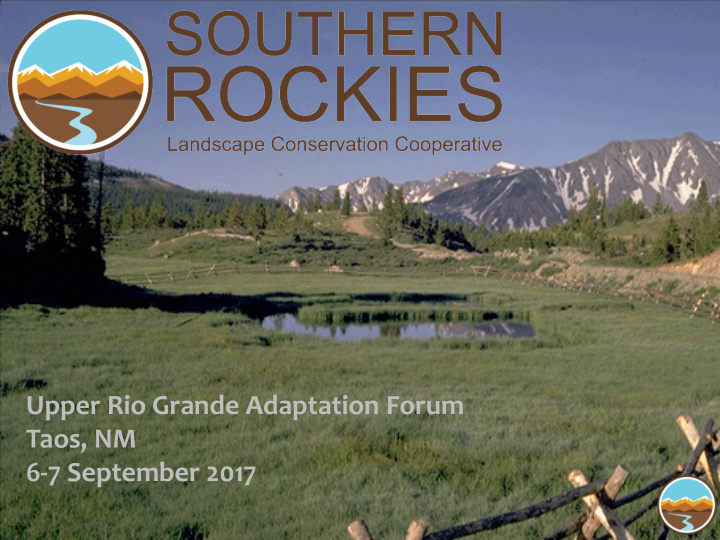



Upper Rio Grande Adaptation Forum Taos, NM 6-7 September 2017
SRLCC Geographic Focus • Where multiple focal resources would benefit • Where significant numbers of Partners are already working or have indicated a desire to work together • Where there is opportunity to leverage work done by partners or the SRLCC • Where partners have indicated they have the dollars and desire to design and implement conservation actions
What is an LCD? Key Elements: • Partnership-Driven: Cross-jurisdictional and multi-sector and operates using collaborative partner-driven processes • Shared Vision: Consensus on Targets, Change Agents (Stressors) and Measurable Indicators • Desired Future Condition: Spatially Explicit • Assessment of Current & Projected Conditions: Spatially Explicit • Conservation Features: e.g., connectivity, ecosystem processes, societal targets; Identifying conservation features allows partners to link goals to specific factors driving change • Strategies: Collaborative recommendations on achieving the vision, goals, and objectives • Spatial products identifying optimal places for actions • Iterative/Adaptive
Landscape Conservation Design Generalized Approach Spatial strategy: How much, o , of what, , wher ere e & W Why • Core… concentrated areas of high ecological value Core • Buffer… around core areas to prevent future degradation • Connect… linkages Buffer between core areas to Connect facilitate connectivity
Landscape Conservation Design Generalized Approach Implement Conservation Network Protect Tactics: Manage • Protect… Core purchase, easement, etc. • Manage… manipulate Buffer Connect • Restore… Restore recreate it Priorities: • Others… High med low
Landscape Conservation Design It is not managing landscapes It is managing resources at landscape-scales
Analytical Framework to identify Conservation Opportunity Areas & Strategies Conservation Opportunity Areas:
Ecosystem Vulnerability (Current and Future) Potential Management Opportunity Areas Actions Existing Conservation Efforts
WHAT DOES THE PRODUCT LOOK LIKE?
Shared Priority Areas – where actions should be focused first + Core Areas Connectivity Zones
Priority Core Areas Low Medium-low 1 1 1 1 Medium 1 1 1 1 Medium-high 1 1 1 1 High WHCWG Linkages Linkage centrality cumulative rating Very high linkage centrality 1 1 1 1 High linkage centrality Number of overlapping WHCWG focal species networks 6 - 9 overlapping focal species networks 4 - 5 overlapp ing focal species networks
LANDSCAPE CONSERVATION DESIGN: David G G. A Anderson on NOT JUST SRLCC S Steering ANOTHER EPISODE Commi mittee M Meeti ting Apri pril 2 29, 2014 OF SOUTH PARK
SPECIES MODELS before after
CONSERVATION VALUE SUMMARY • Overlay of biodiversity conservation value. • Includes CNHP data, potential habitat models, mapped wetlands, and CPW Species Activity Maps (big game). • Weighted by Natural Heritage species status ranks and federal legal status.
MARXAN SOLUTIONS high-risk goals low-risk goals
Partnering on multi-species aquatic assessments to inform efficient conservation delivery Dan Dauwalter , Trout Unlimited/ DFHP Stephanie Vail-Muse , U.S. Fish and Wildlife Service/ DFHP Therese Thom pson , Western Native Trout Initiative, Kevin Johnson , U.S. Fish and Wildlife Service/ Southern Rockies LCC Jodi Whittier , University of Missouri
Multispecies Assessments What are they? Species richness vs. representation Threat level Connectivity
Desert Fish Habitat Partnership
SUMMARY COMMENTS FOR LCD LCD products are useful for gui guiding g miti tigati tion, cons onser ervation eas ion easem ement ents, and mana nagem ement ent d dec ecis ision ions Can create better er ou outcom omes es at lo lower er cos ost and hig higher her ef effic icien iency Can be used to develop and g guide wetland banks ks, payments for ecosystem services, and other her inc incent entiv ive-based p progra rams Supports a shift from om p per ermit it-driv iven en t to o strateg egy-driv iven en a approa oach h at all levels
WHAT’S NEXT
THE END
Recommend
More recommend